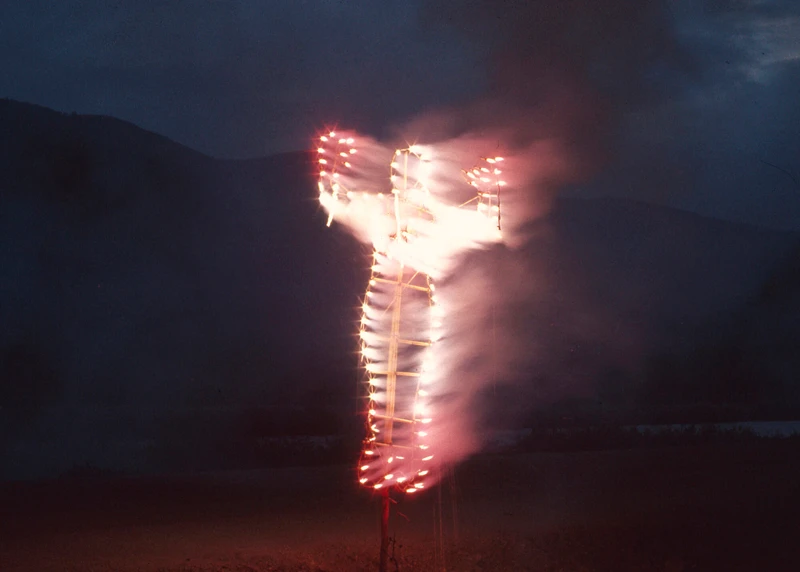Ana Mendieta


b. 1948, United States
d. 1985
Cuban-American sculptor and performance artist, 1948-1985
Ana Mendieta® (b. 1948, Havana, Cuba; d. 1985, New York, US) was a Cuban-born American artist renowned for her earth-body works (the ‘Silueta’ series), for which she transposed her silhouette onto rural landscapes as a means to reconnect with the essence of nature. ‘For the images to have magic qualities’, she once said, ‘I had to go to the source of life, to mother nature.’ Born in Havana, Mendieta was exiled to Iowa in 1961 due to her father’s perilous political situation. (In 1960, evidence came to light indicating that her father, Ignacio, had been trained by an FBI informant.) Mendieta would devote her life and work to an exploration of the consequent feelings of cultural displacement and identity, of presence, nature and violence on and of the body.
Mendieta first began documenting her body in 1971, while studying for an MA at the University of Iowa. She would remove her clothes and lower herself into the earth; she would recreate her body in organic and non-organic materials: stones, soil, grass, flowers, moss, blood. It was during this period that she formulated her earliest earth-body work, Untitled (Grass on Woman) (1972), while also staging performances that tested the relationship between her own body and the bodies of others. Blood + Feathers (1974), which saw Mendieta strip naked and douse herself in the titular components, referenced the rituals of Santería, an Afro-American religion practised in Cuba; for Untitled (Facial Cosmetic Variations), Mendieta transferred the cut beard of a friend onto her own face. As one of the few women at Iowa, these early experiments established Mendieta as an outsider: ‘I really would get it,’ she recalled. ‘The men were into conceptual art and doing things that were very clean.’1
Mendieta did not utilise these ‘unclean’ materials in order to elicit revulsion. ‘I’m not interested in the formal qualities of my materials,’ she once said, ‘but their emotional and sensual ones.’2 Working directly with her own body, Mendieta found that she was able to complicate the seemingly irreconcilable binaries that often define a life: birth/death, nature/nurture, female/male, subject/object. And these were binaries that, while deeply personal to Mendieta, were universally recognisable. ‘The viewer of my work may or may not have had the same experience as myself’, she noted, ‘But perhaps my images can lead the audience to [speculate] on their own experiences.’3
In Mendieta’s eyes, this world was natural before anything else. ‘I become an extension of nature’, she noted, ‘and nature becomes an extension of my body.’4 It was within nature’s bounty that she was able to reconnect with her past and her present, while also contemplating the infinitude of the future. In 1973, for what she would later define as the first Silueta, Mendieta climbed into a Zapotec tomb in Oaxaca and lay naked amongst the foliage. But while Mendieta’s appreciation of the natural might be seen as comparable to that of such notable male land artists as Michael Heizer and Robert Smithson (Mendieta was included in the exhibition, ‘Earth Art, at Cornell University in 1969), hers diverges in its consideration of the spiritual and anthropomorphic. As Jane Blocker notes in Where Is Ana Mendieta? (1990): ‘To anthropomorphize the earth is to endow it with sentience, desire, and identity; it is to think of earth as more than merely a sculptural material.’5
If not a sculptural material, then a restorative one, ‘My art is grounded in the belief of one universal energy which runs through everything […] There is above all the search for origin.’6 For Mendieta, this search engendered numerous works that considered exile and separation, something undoubtedly related to her personal history of emigration. In 1981, she executed the best known of her sculptural works, the Rupestrian Sculptures, in and around a large cave in the Escaleras de Jaruco, Havana. As Blocker notes, it is difficult to look at Isla, from the Silueta series, which features an elongated female figure carved out of the mud of a shallow Iowa creek, and not think of Isla de Cuba. Just as the figure exists as a displaced maquette of Mendieta’s distant homeland, so too does it come to represent a solitudinous female body lain in exile – indeed, a symbol for femininity’s enduring exile.
1.Stephanie Rosenthal, ‘Traces’ in Ana Mendieta: Traces (London: Hayward Publishing, 2013)
2.Ibid.
3.Ibid.
4.Sulfur 22, ed. Clayton Eshleman (Michigan: Ypsilanti, 1988)
5.Jane Blocker, Where Is Ana Mendieta? (Durham: Duke University Press Books, 1999)
6.Ibid.